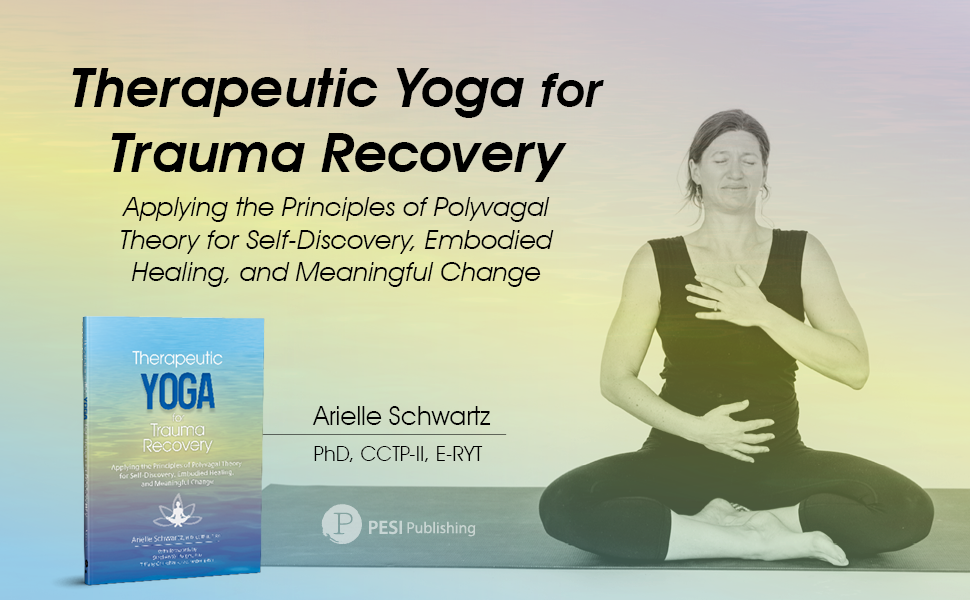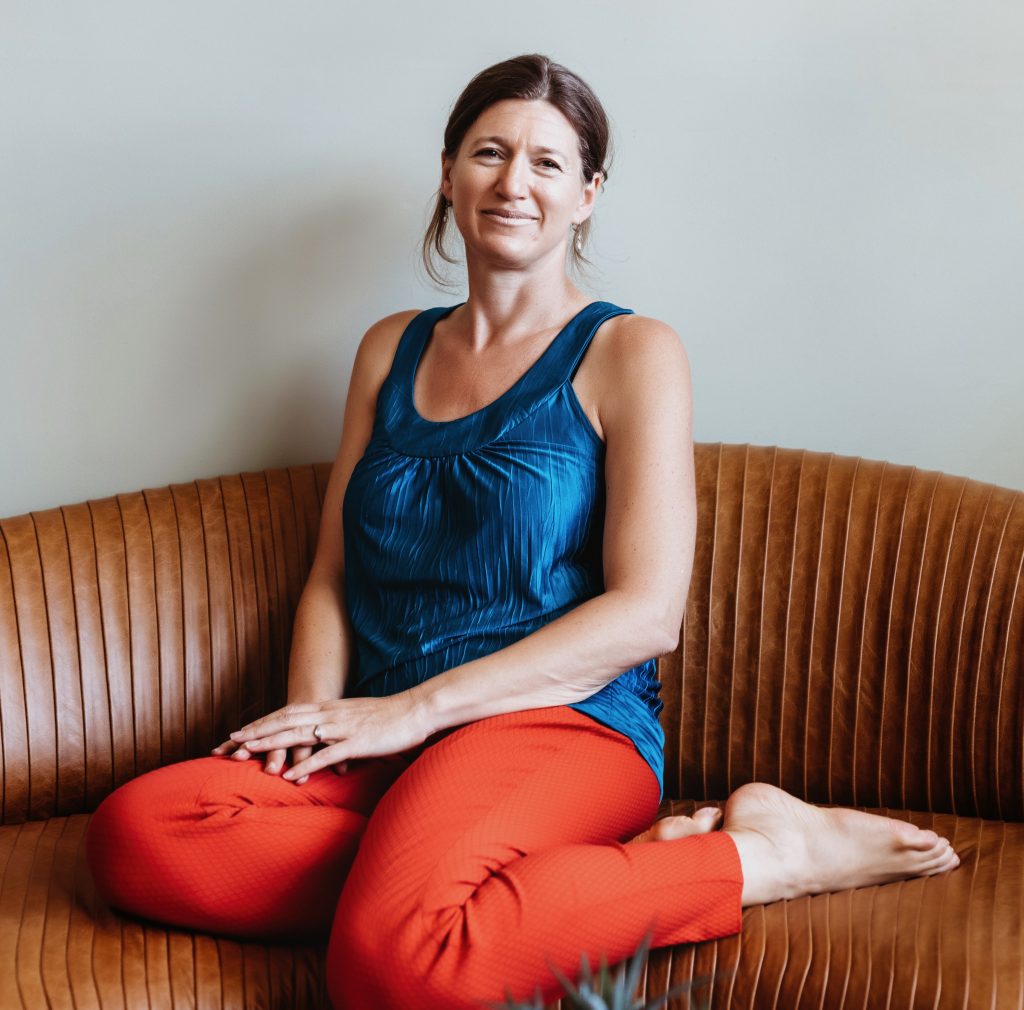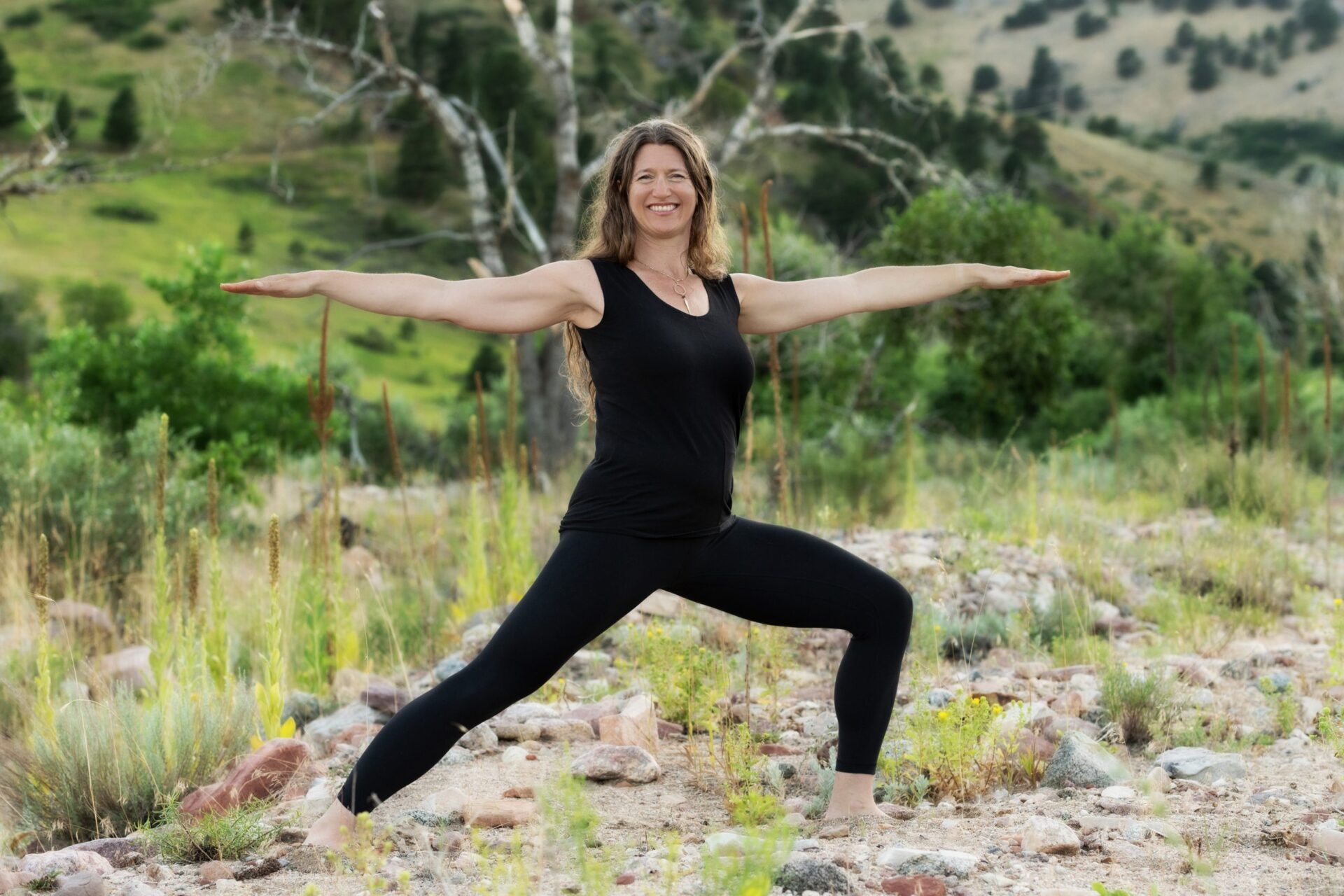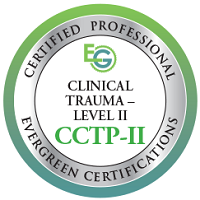Based on the Principles of Therapeutic Yoga

This post is part-two of a series on therapeutic yoga for chronic pain. Part-one provided the science behind the mind-body-pain connection and explored the role of the brain in pain, how trauma exacerbates chronic pain, and why we need to move to heal. In this post, I apply the principles of therapeutic yoga to working with chronic pain conditions such as fibromyalgia, migraines, or back pain.
Yoga is a comprehensive and holistic approach to healing mind and body that involves meditation, breath awareness, spiritual inquiry, and living an ethical life. The word yoga is translated as “union” or to join together the mind and body through disciplined self-awareness. In most yoga classes, a teacher guides you to move with the breath, to focus your mind in the moment, and to cultivate a sense of curiosity about yourself. Within therapeutic yoga, personal inquiry becomes your greatest teacher. There is a decreased emphasis on the directives of an outer teacher guiding the outer shape of a posture and an increased focus on sensory awareness guiding intuitive, healing movements.
“Chronic pain experiences are often debilitating and can be life changing. It is common to feel powerless and overwhelmed. It is important to have predictable practices that offer relief for body, mind, and spirit. The principles of therapeutic yoga for chronic pain provide you with guidelines for your practice.”
-Dr. Arielle Schwartz
Therapeutic Yoga for Chronic Pain

It is important to approach yoga carefully and listen to your body to avoid creating overwhelm or exacerbating chronic pain conditions. In other words, we need to pace ourselves when reclaiming the body from chronic pain conditions. Over time you can reclaim a sense of safety in your body and increase your ability to feel. Maybe you sense tightness in your hips or tension in your chest. Once you feel your sensations you can then use tools of breath and movement to work with your pain—instead of against it. You might notice that vulnerable emotions arise. When the time is right, allow yourself to release and let go as part of your healing.
Consider these principles of therapeutic yoga for chronic pain when looking for the right class or when developing a home-based practice:
- Create a Safe environment: There is no single type of environment that will feel right for everyone. Your yoga space or class needs to feel safe for you. Sometimes this means finding a room that does not have mirrors or a teacher that emphasizes the inner experience instead of the outer look or a posture. Look for a teacher who has been teaching for a while and who knows how to develop modifications of postures that are right for you.
- Focus on Choice: David Emerson, author of Trauma-Sensitive Yoga in Therapy (2015) emphasizes that therapeutic yoga offers an opportunity to “practice making choices” based upon what feels right to you. Chronic pain is not a choice. You might feel powerless or helpless to change your experience. Your yoga practice focuses on the moment by moment exploration of body, breath, behavior. Look for subtle changes that feel good to you. Choices can help you feel empowered!

- Increase Embodied Awareness: Healing chronic pain requires that you increase somatic Yoga is a mindfulness practice that focuses on breathing into sensations and allowing somatic awareness to guide your movements. One of the common mindfulness myths is that you will feel relaxed as a result. Sometimes you will feel calmer, but not always. Actually, paying attention can increase your awareness of turbulent emotions or painful sensations that perhaps you were avoiding. However, mindfulness can give you the tools to work more consciously with difficult experiences.Develop your capacity to stay with painful emotions and sensations without judgment.
- Focus on the Good: Attending to discomfort in the body needs to be balanced with attention to non-pain related stimulus in order to avoid flooding and overwhelm. In yoga, we practice the art of directing and focusing attention. Pain sensations can be overwhelming; therefore, we can alternate awareness of pain with awareness of pleasurable (or neutral) sensations. For example, you might sense the pain in your shoulder and then bring your attention to the tip of your nose attending to the movement of air as you breathe in and out. Or you might prefer to alternate between a pain sensation and an external observation such as gazing at a candle flame.

- Find Healing Movements: Once you build tolerance for sensations you can use the physical yoga postures as an opportunity for self-discovery. According to Alan Fogel, author of Body Sense (2009), awareness of pain becomes an opportunity to reclaim healing movements that were suppressed, sometimes many years ago (See part-one of this series to understand movement suppression contributes to chronic pain.) Perhaps you stand up tall and reach your arms up to the sky. How good it can feel to expand and extend your limbs long and outstretched. Maybe you get low on your hands and knees and curl yourself up into a small, contracted shape. In my therapeutic yoga classes, I like to invite participants to move intuitively. The shapes that you make with your body will not have a fancy Sanskrit name, nor is there a goal for postures to be perfectly aligned. Rather, your movements are healing actions. For example, if you have a knot in your throat ask yourself if there is a sound that matches the feeling. Or, if you feel tightness in your hips notice if you can become aware of any corresponding emotional tone. Your sensations are invitations for movement. Just like a full body yawn…imagine that you are your favorite animal just waking up from a nap. Like the lion in the photo above, you can see that pandiculation is a process that involves both stretching and contracting the body. Pandicular movements are deeply healing as they are the nervous system’s way of waking up sensory-motor system. These healing movements prevent the build-up of chronic muscular tension and increase voluntary control over your muscles.
- Seeking Serenity: When working with chronic pain, we recognize that there are some aspects of our experience that we can change, and some that we cannot. You can actively focus on decreasing the fear that amplifies pain or creating lifestyles changes that increase mind-body health such as healthy nutrition or getting better sleep. However, we must also accept that not all health challenges can be changed, no matter how hard you try. Here, you can focus on acceptance, self-compassion, surrender, and processing grief about living with pain.
Relief from Chronic Pain

Move, breathe, stretch, contract, and release.
Hopefully, by now you understand why I have not directed you into a specific sequence of physical yoga postures that will heal your fibromyalgia, chronic migraines, or back pain. Instead, I hope that I have inspired you to trust yourself and your body. Your sensations are your teacher—your yoga.
(photo credits: Victor Tondee, Creative Commons)
Therapeutic Yoga for Trauma Recovery

This post has excerpts from the book, Therapeutic Yoga for Trauma Recovery,
This book introduces you to the power of the yogic philosophy and offers a variety of accessible yoga poses and breathing practices that will allow you to:
- Nourish your nervous system
- Reconnect with your body
- Ground yourself in the present moment
- Release unresolved patterns of fight, flight, freeze, or faint
- Widen your ability to tolerate emotional discomfort
- Develop a felt sense of resilience
- Anchor yourself in self-love
- Reclaim connection with and trust in your body
- Create a personalized yoga practice for your own self-care
About Dr. Arielle Schwartz

Arielle Schwartz, PhD, is a psychologist, internationally sought-out teacher, yoga instructor, and leading voice in the healing of PTSD and complex trauma. She is the author of five books, including The Complex PTSD Workbook, EMDR Therapy and Somatic Psychology, and The Post Traumatic Growth Guidebook.
Dr. Schwartz is an accomplished teacher who guides therapists in the application of EMDR, somatic psychology, parts work therapy, and mindfulness-based interventions for the treatment of trauma and complex PTSD. She guides you through a personal journey of healing in her Sounds True audio program, Trauma Recovery.
She has a depth of understanding, passion, kindness, compassion, joy, and a succinct way of speaking about very complex topics. She is the founder of the Center for Resilience Informed Therapy in Boulder, Colorado where she maintains a private practice providing psychotherapy, supervision, and consultation. Dr. Schwartz believes that that the journey of trauma recovery is an awakening of the spiritual heart.
- The Complex PTSD Workbook: A Mind-Body Approach to Regaining Emotional Control and Becoming Whole (Althea press, 2016)
- EMDR Therapy and Somatic Psychology: Interventions to Enhance Embodiment in Trauma Treatment (Norton, 2018).
- The Post-Traumatic Growth Guidebook: Practical Mind-Body Tools to Heal Trauma, Foster Resilience, and Awaken your Potential (Pesi Publications, 2020)
- A Practical Guide to Complex PTSD: Compassionate Strategies for Childhood Trauma (Rockridge Press, 2020)
- The Complex PTSD Treatment Manual: An Integrative Mind-Body Approach to Trauma Recovery (Pesi Publications, 2021)
- Trauma Recovery: A Mind-Body Approach to Becoming Whole (Sounds True, 2021)
- Therapeutic Yoga for Trauma: Applying the Principles of Polyvagal Theory for Self-Discovery, Embodied Healing, and Meaningful Change (Pesi Publications, 2022)








